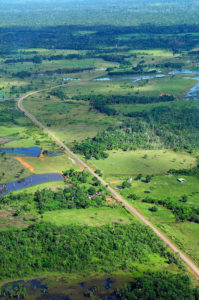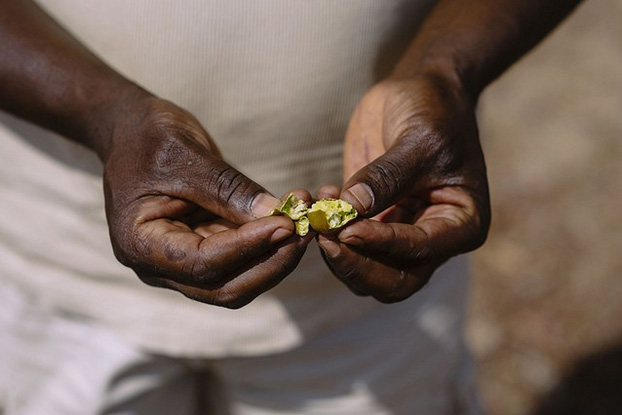
By Pablo Pacheco, originally published at CIFOR’s Forests News
The successful Brazilian experience in slowing down deforestation in the Amazon has captured a lot of attention in the global arena, but serious concerns linger about its possible resurgence.
While it is important to strengthen public and private arrangements to reach zero deforestation, or at least to stabilize it at relatively low absolute levels, more attention needs to be placed on the actions necessary to facilitate the transition from a zero-deforestation model to one of territorial sustainability.
This is the focus of a recent infobrief produced by scientists from the Center for International Forestry Research (CIFOR), the French Agricultural Research Center for International Development (CIRAD) and the Brazilian Agricultural Research Corporation (EMBRAPA) in the context of the TerraCert Project, which is implemented in the Municipality of Paragominas in the State of Pará.
The paper’s main argument is that while constraining deforestation expansion on farms is a necessary condition, it is not enough to facilitate the adoption of more sustainable land uses and production practices at the farm and landscape levels — both of which are essential to increasing territorial sustainability in the Amazon.

Much of the current debate on the slowdown of deforestation and territorial sustainability has to do with improving the sustainability of cattle ranching, which is seen as the main culprit of forest loss in the Amazon. Pasture expansion is responsible for more than two-thirds of the total accumulated deforestation in this region. Deforestation is generally associated with large and medium-scale ranching, but it also involves smallholders.
In light of this evidence, common thinking suggests that halting deforestation while simultaneously supporting the intensification of cattle production (i.e. allowing more intensive agriculture to replace low productive pasture lands) and promoting integrated crop-livestock-tree farming systems could constitute effective ways to support more sustainable landscapes in the Brazilian Amazon.
Up until now, a governance approach combining public policy and private initiatives has been effective in slowing down deforestation, but it has been unable to support a transition to more sustainable production systems. Building on current successes in reducing deforestation, new steps are necessary to achieve territorial sustainability. These require combining institutional arrangements and sociotechnical options.
New technical intensification models must be identified for low-productivity systems in degraded lands and adapted to the biophysical, social and technical conditions of the Amazonian landscapes. But since multiple constraints inhibit the uptake of these intensification options, reversing them requires that all constraints be addressed in a coordinated way.
Based on our research, we suggest three sets of actions to support making that vision a reality by involving the use of adapted production technologies, adopting monitoring systems that empower local actors, and implementing new public-private institutional arrangements.
Keys to slowing down deforestation

It is now a known fact that efforts to enforce environmental regulations coupled with commitments from soy traders and the meat packing industry has helped to reduce deforestation. A critical step was the adoption of the Agreement for the Adjustment of Conduct (TAC) by which the meat packing industry agreed to enact stricter controls on their suppliers, forcing them to follow state regulations. This agreement was followed by another one signed between three major meat packing groups and the NGO Greenpeace with similar terms to those agreed under the TAC, but with the added layer of control mechanisms over indirect suppliers.
In addition to these two agreements, other types of initiatives to support progress toward more sustainable intensification of cattle ranching have also emerged in the Brazilian Amazon based on the understanding that decoupling cattle ranching development and deforestation requires embracing cattle intensification and low-carbon development.
One group of initiatives is trying to establish guidelines, standards and pilot projects to support the intensification of cattle ranching, while another group is now seeking to provide the necessary incentives for farmers to embrace these improved farming systems.
The expansion of extensive cattle ranching has generated large areas of low-productive pasture. These lands are prime candidates for pasture intensification, and different initiatives have emerged to do that. EMBRAPA has proposed two main models: 1) Integrated crops-livestock-trees systems 2) The Good Practice Program for intensive pasture management. Additionally, several private pilot initiatives, as well as others promoted by NGOs, are implementing intensive systems in experimental farms with diverse outcomes.
One main consideration in the implementation of these systems is financing. Farmers are limited financially to uptake improved farming systems. To remedy this, the Brazilian government has developed a large credit plan for financing low-carbon agriculture called the Agricultura de Baixo Carbono (ABC) Program. However, the reach of this program is still limited, and farmers face difficulties meeting its requirements, specifically in regards to land titling. In addition, commercial banks are constrained since they face relatively high financial and reputational risks when financing economic activities in the Amazon.
Challenges for sustainable ranching

Sustainable cattle ranching in the Brazilian Amazon cannot be limited to reducing deforestation linked to the increased intensification of direct suppliers of the meatpacking companies who are mainly large-scale producers. Instead, it should aim to improve land, pasture and other economic assets to achieve a reduction in deforestation, while also enhancing the social, economic and environmental performance of cattle ranching production systems (i.e. the restoration of environmental liabilities).
So far, the meat packing industry has upheld their commitments with the government tracing their direct sources of supply, but it is becoming difficult to control indirect suppliers. While large-scale direct suppliers follow high production standards, indirect suppliers, including medium-scale and smallholder farmers, should also play by the same rules.
The Brazilian Amazon also holds significant potential for biomass production (much higher than other Brazilian regions) especially for the production of forage, grains, perennial crops and timber. The proposed technical production models aim to maximize land productivity with relatively high costs of labor, equipment and inputs, and are very demanding in knowledge and labor quality. For this reason, these models risk increasing environmental impacts linked to the massive use of chemical inputs. Also, it is likely that a large number of less resource-endowed farmers will not be able to adopt these production models.
Moreover, intensification processes tend to occur in more fertile and accessible lands, which are not necessarily the degraded lands in most need of recovery. Degraded pastures are unlikely candidates when it comes to paying for costs and delivering the economic returns demanded by the currently promoted intensification systems. Alternatives have not been sufficiently explored that might be better adapted to degraded lands, small-sized farms, and taking advantage of existing natural resources in the Amazon region. These alternatives are more compatible with the concept of agroecology, in contrast to the high-input models.

Linking sustainable ranching to territorial sustainability
Achieving sustainability in the Brazilian Amazon’s agricultural frontiers requires not only public-private institutional arrangements aimed at enforcing compliance of environmental laws, but also incentives and reward systems that facilitate the uptake of improved production practices, thus fostering a transition from production systems that negatively affect natural resources to systems that use natural resources more efficiently. Three complementary actions may contribute to achieving this goal:
1) Developing and operationalizing adapted technologies
Focusing on technologies with the potential to better utilize the existing natural resources in the Amazon (i.e. soil fertility, hydric resource availability) instead of using massive chemical inputs. This approach has the potential to support a large number of less resource-endowed farmers rather than only a handful of large-scale well-capitalized cattle ranchers, and is adapted to vast areas of degraded land. An essential aspect to consider is the spatial configuration of these systems at the landscape scale, which should match the location of natural resources in order to build eco-efficient landscapes.
2) Implementing monitoring frameworks that empower local actors
Assessing progress towards the achievement of sustainable cattle intensification must be part of broader territorial performance monitoring — not only to assess progress, but also to identify the factors limiting such progress. Jurisdictions capable of measuring progress in their performance to show that they are doing their part in improving sustainability will likely be more attractive to investors. This can help prioritize public interventions (i.e. land regularization, public credit lines). This process, however, requires important collective action.
3) Fostering institutional arrangements that embrace territorial approaches
Public and private agreements to reduce deforestation and achieve sustainable cattle intensification have to be conceived as part of efforts to improve territorial performance in sub-national jurisdictions, like municipalities. It is at this level that achieving sustainability (including social inclusion, gains in productivity and the maintenance of environmental services) can be better specified. Additionally, territorial approaches have the potential to articulate efforts from a diverse range of actors, and can trigger partnerships to stimulate technical and institutional innovations and mutual learning.
These three actions — aimed at improving the uptake of adapted eco-efficient technologies; monitoring and certifying the progress of territorial performance towards sustainability; and enhancing institutional arrangements to trigger innovation and mutual learning — are the constituent pieces of an approach aimed at achieving territorial sustainability in specific jurisdictions. Different players are already investing efforts in this direction. Let’s keep working together to make territorial sustainability a reality.
—————————-
CIFOR in collaboration with CIRAD and the Working Group on Sustainable Beef (GTPS) is organizing the session “Territorial approaches to reduce deforestation and support sustainable supply in the Amazon” at the Second General Assembly of the TFA 2020. This session will host a discussion about ongoing experiences to reduce deforestation while supporting production intensification by embracing territorial perspectives. It will discuss the advantages and limits of the different territorial approaches, and highlight main issues that require further consideration from the perspective of different stakeholders. The session will be held on 20 March, from 16:00 to 17:30 at the Hotel Royal Tulip Brasilia.












